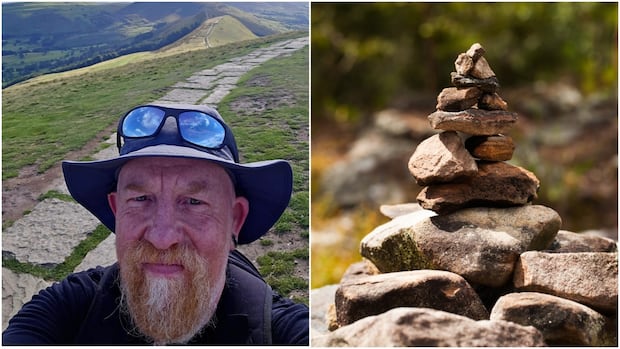As It HappensWhy this British hiker keeps kicking over people’s picturesque stone stacks
Stuart Cox is waging war against the hundreds of stone stacks that people keep leaving all over his favourite hiking trails.
The decorative structures, he says, are destroying local archaeology, damaging trail systems and disrupting wildlife. So when he sees one, he destroys it.
His weapon of choice?
“Brute force and a size 11 boot,” the British hiker told As It Happens guest host Catherine Cullen.
Cox has garnered millions of views and international headlines for his expletive-laden videos, posted this spring and summer, in which he kicks down stone stacks in Peak District National Park in central-northern England.
Some commenters have condemned his curmudgeonly boots-to-rock approach, but he has the support of both park authorities and conservation scientists.
‘Nothing is safe from humans or Instagram’
Human-made stone piles, sometimes called cairns, are found in many cultures around the world, and have historically been used as burial mounds, reference points and navigational tools.
In Canada, the most iconic cairns are inukshuks. Originally built by the Inuit, these people-shaped structures are traditionally used to mark travel routes, hunting grounds, food caches and more.
But in recent years, the activity known as stone-stacking or rock-balancing has become a common pastime for hikers of all stripes — and, increasingly, a headache for the folks who manage public lands.
National parks in France, the U.S. and more have issued warnings against stone stacking.
In Canada, the Jasper National Park in Alberta and Gros Morne National Park in Newfoundland have both pleaded with the public to stop building inukshuks on mountains and trails.
Cox says he’s seen literally hundreds of stone structures on the historic Peak District trails, some as tall as a person, spread out as far as the eye can see.
“Since people are on TikTok and Instagram, they’ll post a nice picture with a stone stack and then clear off and go home and leave it. And before you know it, I think once people see one there, they’re like sheep, aren’t they? And they follow the herd,” he said.
“Nothing is safe from humans or Instagram.”
That rock could be a critter’s home
So what’s the problem with stacking stones? Rocks, it turns out, have a job to do.
They provide habitat, protection, feeding grounds and more for a variety of wildlife, including snails, insects, lizards and plants.
“We already have a significant impact on the planet as it is,” Ricardo Rocha, an associate professor of conservation science at the University of Oxford, told CBC in an email. “Nature doesn’t need people further disturbing natural environments by stacking stones.”

Rocha is the co-author of a 2020 letter to the editor, published in the journal Human-Wildlife Interactions, calling stone-stacking a “looming threat to rock-dwelling biodiversity.”
While he admits the impact is probably less severe along well-worn trails, he says people often go off the path in search of rocks to stack.
And even if they put them back where they found them after they’ve snapped their pictures, he says moving them at all can disrupt an ecosystem’s balance.
Asked what he thinks of Cox’s approach to raising awareness about the negative impacts of stone-stacking, Rocha said: “In the words of the civil rights activist John Lewis, he seems to be engaging in ‘good trouble, necessary trouble.'”
Damaging to trails and historic sites
In some cases, these Instagrammable structures can be dangerous for people, too.
Some parks use cairns as official trail makers, which means the rogue ones can lead people astray.
That’s what happened in May to a hiker in Arizona who, according to a local police, had to be rescued after he strayed from the trail and got lost while following a series of unauthorized cairns near the summit of Granite Mountain.
In the areas Cox frequents, he says people sometimes remove stones that have been placed there intentionally to reinforce the trails, creating a risk of erosion and flooding.
Other times, he says, they take rocks from an ancient stone wall that, according to the U.K. National Trust, dates back to 1579 and has itself become home to a wide array of wildlife, or from the Mam Torn hillfort, a protected Bronze Age historical site that includes, among other things, stone-laden burial mounds.
“So they’ve been there probably up to 4,000 years and people are coming along and removing rocks from them, which isn’t great,” he said.
Cox’s claims have been backed up by the Peak District National Park Authority, which told BBC News stone stacks are “detrimental” to the area, and the U.K. National Trust, which told the British broadcaster: “Sadly, the stone stacks are not only impacting the history of the site, but they are also affecting the natural habitats of wildlife that live and feed within these ancient walls.”
Cox admits his approach to conservation is “a bit dramatic” and can ruffle feathers. But most people, he says, simply don’t know better and are grateful for the education.
He says he even once pushed over someone’s nearly two-metre stone stack just as they were taking a photo of it.
“Initially, they were quite upset. But to be fair to them, once I explained the reason for me doing that, they were actually [like] ‘Oh, well we didn’t know that. Now we do know that this is actually quite damaging, we won’t do it again,” he said.
“So the message got through.”







